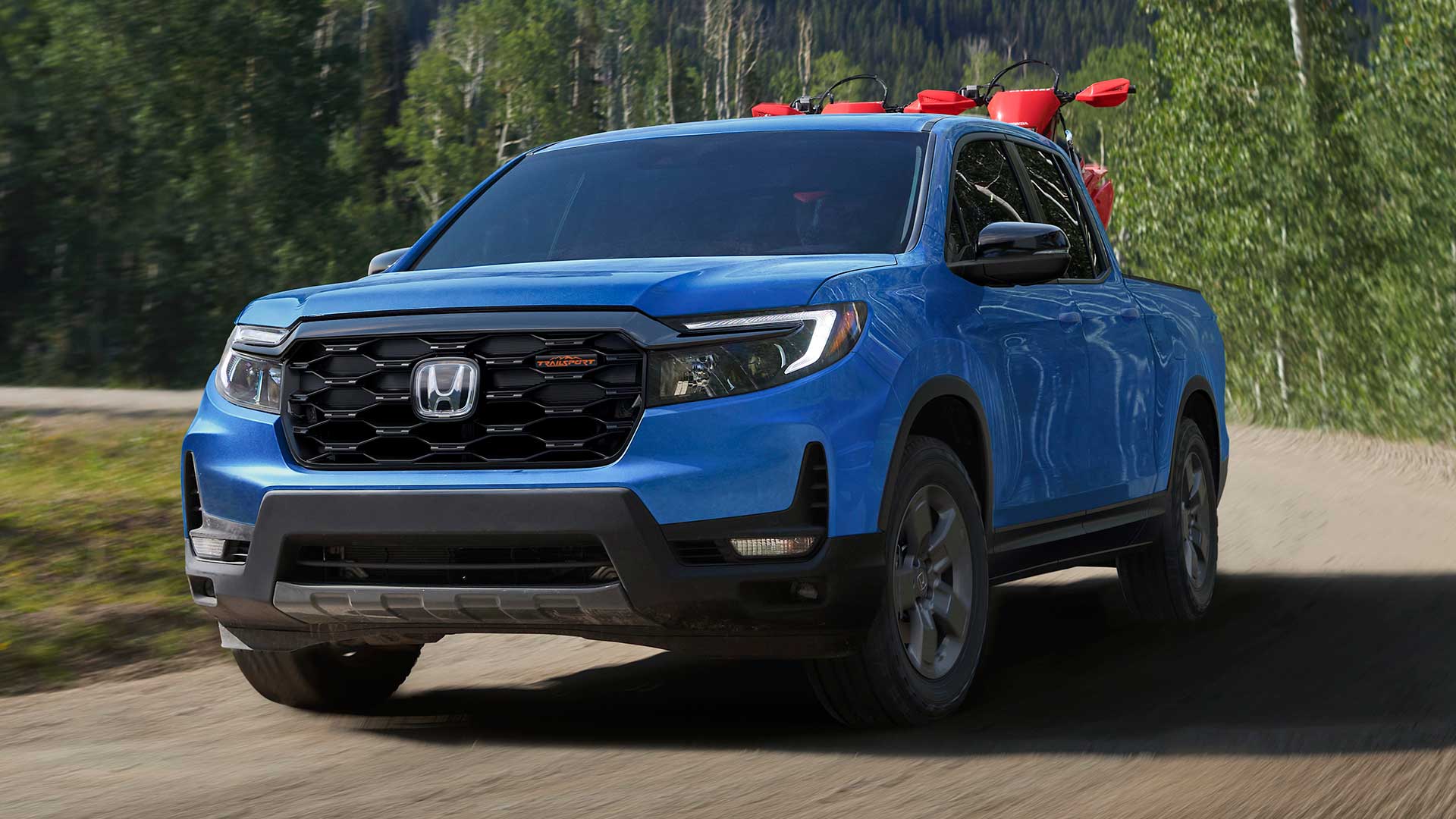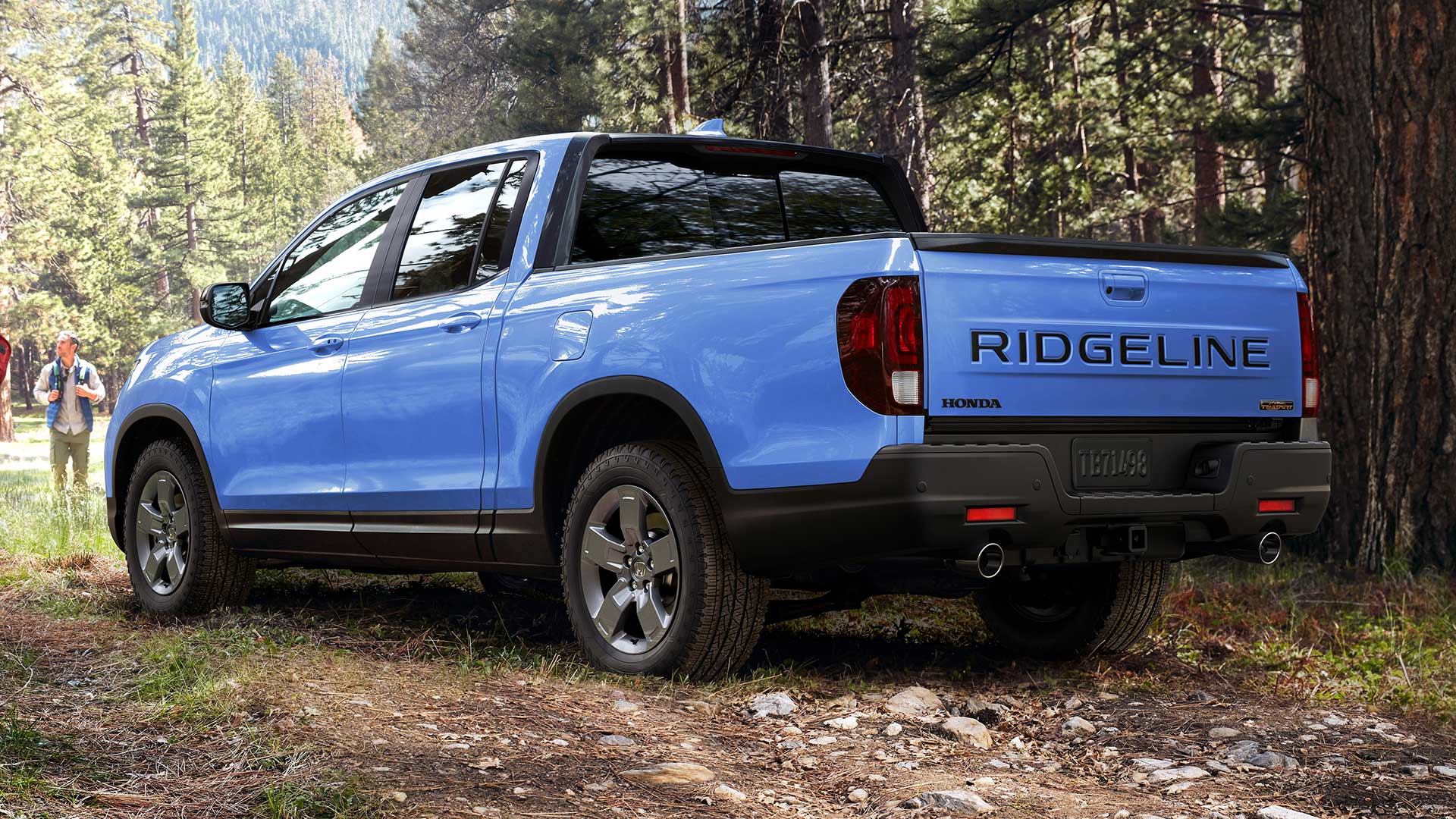2010 Buick LaCrosse
After decades of being too closely associated with older, more conservative buyers, Buick made a breakout in appealing to a younger, more affluent set with the 2008 Enclave crossover utility. The Enclave has been an unqualified success. A second effort is ready with the all-new Lacrosse sedan. While the name is familiar, the car is anything but. It’s a fresh approach with stunning good looks inside and out. Now we’ll see if the Lacrosse can deliver.
Except for the name, the 2010 Buick LaCrosse is all-new. And even that was a point of discussion, since it was first revealed as the Invicta concept at last year’s Beijing Auto Show, and is sold in Canada as the Allure. Its sexy, Asian-penned styling could be mistaken for anything from a Lexus to a Mercedes. Scimitar blade-shaped headlamps flank an Enclave-like waterfall grille. Stylized Buick portholes have migrated from the fenders to the hood.
A high beltline makes room for a deeply sculpted “sweepspear” body line, and provides the greenhouse a low-slung look, even though this LaCrosse is two inches taller.
The less-original rear has lots of chrome- on the license plate header, edging the taillights, and plating the dual exhaust. Wheels come in 17’s, 18’s, or our top-of-the-line CXS Touring’s 19-inch chrome-painted alloys wearing low-profile Eagle RS-A rubber. As part of the ground-up redesign, the outgoing LaCrosse’s pushrod engines are gone, replaced by a trio of twin-cam motors, all with fuel saving direct fuel injection, and a six-speed automatic transmission. Base CX and mid-level CXL share a 3.0-liter V6 with the new Cadillac SRX, churning out 255 horsepower and 217 pound-feet of torque.
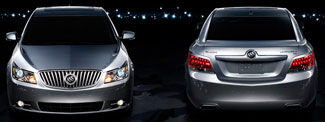 Our LaCrosse CXS sports the same award-winning 3.6-liter V6 that powers the Enclave, rated at 280 horsepower and 259 pound-feet of torque. It will be available in front or all-wheel-drive, a first for a Buick car. Due soon is the Malibu’s frugal Ecotec 2.4-liter four cylinder. This new base is rated at 182 horsepower and 172 pound-feet of torque, with highway fuel economy well into the 30’s.
Our LaCrosse CXS sports the same award-winning 3.6-liter V6 that powers the Enclave, rated at 280 horsepower and 259 pound-feet of torque. It will be available in front or all-wheel-drive, a first for a Buick car. Due soon is the Malibu’s frugal Ecotec 2.4-liter four cylinder. This new base is rated at 182 horsepower and 172 pound-feet of torque, with highway fuel economy well into the 30’s.
But even our CXS 3.6 did pretty good in that area. Government fuel economy ratings are 17 city, 27 highway. We achieved a fine 24.5 mpg in real-world driving with regular gas. With an Energy Impact Score of 16.3 barrels of oil consumed annually, and a carbon footprint of 8.7 tons of CO2 per year, the LaCrosse CXS is on par with its premium rivals. Ditto acceleration: zero to 60 in a respectable 7.5 seconds, with a quarter mile of 15.9 at 90 mph. The big six delivers fine low-end power off the line. Shifts, however, were soft and delayed.
Handling from its new-generation Epsilon platform was actually better than expected. Despite some tendency to understeer, the LaCrosse shifted its weight well along a taut suspension equipped with optional real-time damping. Steering had reassuring heft and a strong self-centering feel. With standard stability and traction control, LaCrosse is much nimbler than its 4065-pound curb weight suggested. Grippy anti-lock disc brakes and a nicely-modulated pedal made for stops averaging a short 125 feet from sixty. Stability was excellent.
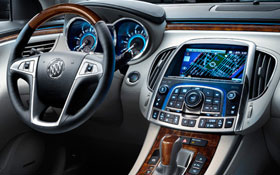 Now for the best part; Invicta’s gorgeous and emotional interior theme was delivered intact for LaCrosse, including elegant door treatments, twin-pod instrument cluster, cool blue lighting, and graceful center console. Beefy seats are wrapped in finely-stitched soft leather with available heat and ventilation. Eight-way power is standard for the driver as is excellent lateral support.
Now for the best part; Invicta’s gorgeous and emotional interior theme was delivered intact for LaCrosse, including elegant door treatments, twin-pod instrument cluster, cool blue lighting, and graceful center console. Beefy seats are wrapped in finely-stitched soft leather with available heat and ventilation. Eight-way power is standard for the driver as is excellent lateral support.
All trims are equipped with satellite radio, automatic climate, and OnStar. Our CXS was loaded up with navigation and rear view camera, oversized sunroof, and head-up display. The split rear seat cushions are a little low, but there is generous legroom, besting the Lexus ES 350 by 4 1/2 inches. There’s an armrest with pass through, an available power rear sunshade, and dual screen DVD. The trunk, however, at 12.8 cubic feet, is smaller and less useable than the ES’.
Base pricing for the LaCrosse is $27,835 for the CX; the CXL starts at $30,395, $32,570 with all-wheel-drive, and the CXS starts at $33,765. In China, where Buick is number one in sales, the venerable brand is revered as a style-setter. With the Enclave, and now the 2010 LaCrosse, that image is starting to take hold in America as well. The “new” General Motors has a lot riding on the success of the LaCrosse, and from where we sit, this ride looks fantastic.
Specifications
- Engine: Cxs 3.6-Liter V6
- Horsepower: 280
- Torque: 259 Lb Feet
- 0-60 MPH: 7.5 Seconds
- 1/4 Mile: 15.9 Seconds @ 90 MPH
- 60-0 MPH: 125 Feet
- EPA: 17 MPG City/ 27 MPG Highway
- Mixed Loop: 24.5 MPG
- Energy Impact: 16.3 Barrels Oil/Yr
- CO2 Emissions: 8.7 Tons/Yr
2024 Honda Ridgeline TrailSport
It Does Truck-Like Things Better Than Ever
Honda brought something truly unique to the pickup truck scene when their mid-size Ridgeline debuted for 2006. In 2017, it moved towards becoming a little more true truck-like, both in form and capability, now with yet another step in that direction for 2024. So, let’s see if the Ridgeline is really hitting its stride.
For 2024, it’s all about making this Honda Ridgeline better than ever. There are styling tweaks outside, along with tech and functional improvements inside, but the biggest news is the Ridgeline has now joined Honda’s TrailSport family of off-road inspired vehicles. This more-true-trucklike, second-gen Ridgeline been around since 2017, receiving periodic updates over the years; but joining the TrailSport family is the biggest leap yet.
Primarily, the TrailSport transformation includes General Grabber all-terrain tires, mounted on new Pewter Gray 18-inch wheels, steel underbody protection, and retuning the strut front, and multi-link rear suspension for added wheel articulation. And while we always appreciate the additional traction of off-road tires, the Ridgeline’s standard i-VTM4 all-wheel drive, with Intelligent Traction Management and snow, sand, and mud settings, was already quite capable of handling all but the most extreme off-roading, ground clearance of just 7.6 inches being it’s only real hinderance.
A 3.5-liter V6 remains under the hood as it has since the Ridgeline debuted for 2006; the current version outputs 280 horsepower and 262 lb-ft of torque, plenty enough muscle to handle its 5,000-lbs. towing capacity. A nine-speed automatic transmission with paddle shifters and bevy of push and pull buttons on the console replaced the six-speed automatic back in 2020.
In addition to adding TrailSport capability, a big focus for this update was making it more user-friendly inside, starting with the central touchscreen growing from 8 to 9 inches. It also gets faster processing speeds, menus have been simplified, and the native navigation system is improved with better graphics. It’s accompanied by a new digital instrument cluster, along with an upgraded center console with more storage space. Unique TrailSport touches include heavy duty floormats, leather-trimmed seats, orange stitching throughout the cabin, and orange ambient lighting.
The Ridgeline continues to offer things available nowhere else in the pickup truck market.
Exterior styling doesn’t exactly shout “macho big rig coming your way,” but the more vertical face and larger grille that arrived for 2021, along with this year’s added TrailSport elements, do continue to toughen up the Ridgeline’s image. The 5’4” bed remains highly functional with no large wheel well intrusions, multiple tie-downs points, lighting and even speakers. And of course, the Ridgeline continues to offer things available nowhere else in the pickup truck market, like the dual-action tailgate, and large, lockable, drainable, underbed storage. Not to mention being able to drive around in true car-like comfort, something we took full advantage of on our way to our Mason Dixon Dragway test track.
There was great grip off the line, with full power arriving smoothly but quickly, helping us to get to 60 in 7.0 seconds flat, a tenth quicker than the last Ridgeline we tested. That power delivery stayed fairly consistent the whole way down the track, barely interrupted by the nine-speed automatic’s smooth shifting. Our best quarter-mile run was 15.5 seconds at 90 mph.
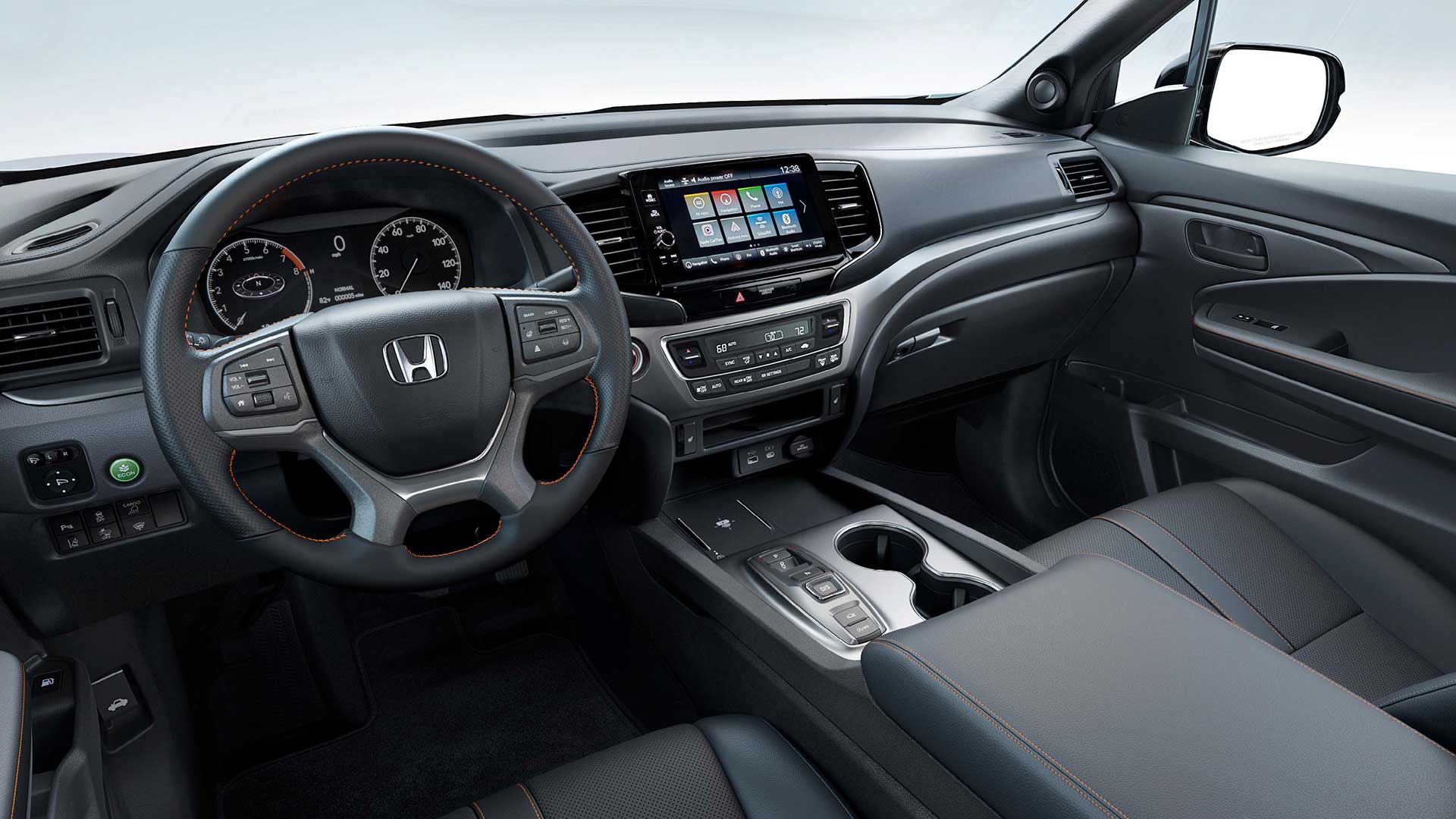
The revised suspension and knobbier tires didn’t really seem to add or detract from handling prowess, as it felt as solid, nimble, and car-like as it always has through our cone course. Perhaps a little less stiff than before, but good feedback, tight steering, and minimal body roll for a pickup, made for a very confidence inspiring experience. In our braking test, we stopped in a respectable average of 123 feet from 60, with only moderate amounts of nosedive and good feel through the pedal.
There is, however, a slight reduction in Government Fuel Economy Ratings with the all-terrain tires; 18-City, 23-Highway, and 20-Combined, our average, right on, at 20.4 mpg of Regular. That’s a slightly below average Energy Impact Score of 14.9 barrels of yearly oil use, with CO2 emissions of 7.4 tons.
TrailSport pricing falls in line just under the Ridgeline’s top Black Edition trim with a starting price of $46,375, about five grand over a base Ridgeline Sport.
So, whether you consider the Honda Ridgeline to be a “real” truck or not, this ruggedly smooth 2024 TrailSport does truck-like things better than ever. And we’re not just talking about the slight upgrade in off-road performance, we’re talking about a flexible bed to help you get chores done, and the ability to tow or haul with comfort and flexibility other trucks can only wish for. It’s why the Ridgeline brings more first-time buyers to Honda than any other vehicle, and why it continues to be a great choice in the growing midsize truck realm.
Specifications
- Engine: 3.5-liter V6
- Transmission: 9-speed automatic
- Horsepower: 280
- Torque: 262 lb-ft
- EPA: 18 City | 23 Highway | 20 Combined
- 0-60 mph: 7.0 seconds
- 1/4 Mile: 15.5 seconds at 90 mph
- 60-0 Braking (avg): 123 feet
- MW Fuel Economy: 20.4 mpg (Regular)
- Max Towing Capacity: 5,000-lbs








